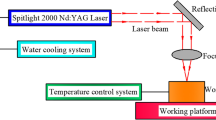Abstract
During the gas blow forming of AZ31 magnesium alloy, the heavy pulse current was applied. The effects of pulse current on the cavitation during superplastic forming were examined. Scanning electronic microscopy (SEM) was employed to observe the cavities and topography of the forming samples. Theoretical analysis and experimental results show that the pulse current flowing through the cavity tip will form a local high-temperature zone and local compressive stress area near the vicinity. It is helpful to heal the cavity and avoid the further growth; at the same time, the non-thermal effect of pulse current will also affect the cavity nucleation and growth, thereby changing the morphology and distribution of cavities. It delayed the appearing of large size cavity to some extent, avoiding the material premature fracture and helping to improve the forming limit of the material during the superplastic deformation.












Similar content being viewed by others
References
A. Fata, G. Faraji, M.M. Mashhadi, V. Tavakkoli, Hottensile deformation and fracture behavior of ultrafine-grained AZ31 magnesium alloy processed by severe plastic deformation. Mater. Sci. Eng. A. 674, 9–17 (2016)
F. Fereshteh-Saniee, N. Fakhar, F. Karami, R. Mahmudi, Superior ductility and strength enhancement of ZK60 magnesium sheets processed by a combination of repeated upsetting and forward extrusion. Mater. Sci. Eng. A. 673, 450–457 (2016)
S.A. Torbati-Sarraf, T.G. Langdon, Properties of a ZK60 magnesium alloy processed by high-pressure torsion. J. Alloys Compd. 613, 357–363 (2014)
Q. Yang, B. Xiao, Z. Ma, Enhanced superplasticity in friction stir processed Mg–Gd–Y–Zr alloy. J. Alloys Compd. 551, 61–66 (2013)
J.L. Li, D. Wu, Q.B. Yang, R.S. Chen, Superplasticity of multi-directional impact forged Mg–Gd–Y–Zr alloy. J. Alloys Compd. 672, 27–35 (2016)
B. Kim, J.G. Lee, S.S. Park, Superplasticity and load relaxation behavior of extruded Mg–8Sn–3Al–1Zn alloy at 250 °C. Mater. Sci. Eng. A. 656, 234–240 (2016)
D.L. Yin, K.F. Zhang, G.F. Wang, W.B. Han, Superplasticity and cavitation in AZ31Mg alloy at elevated temperatures. Mater. Lett. 59, 1714–1718 (2005)
M.Q. Li, Y.Y. Chen, D.J. Chen, Electric field modification during superplastic deformation of 15 vol.% SiCp/LY12 Al composite. J. Mater. Process. Technol. 73, 264–267 (1998)
M.Q. Li, S.D. Wu, Electric field modification during superplastic deformation of LY12CZ duralumin. Acta Metall. Sin. 31, 272–276 (1995)
H.L. Fan, P. Chen, Crack arrest effect in thin plates. Acta Armamentarii 26, 791–794 (2005)
X.Z. Bai, Y.D. Hu, Application of electromagnetic thermal effect theory in thin plate crack prevention technology (in Chinese), in National Conference on Modern Mathematics and Mechanics, 2000
Q.B. Li, Diffusion Phase Transition in Alloys and Thermodynamics of Alloys (in Chinese). (Science and Technology Press of Liaoning, 1984)
X.G. Jiang, J.Z. Cui, L.X. Ma, A cavity nucleation model during high temperature creep deformation of metals. Acta Metall. Mater. 15, 305–309 (1993)
R. Raj, Nucleation of cavities at second phase particles in grain boundaries. Acta Metall. 26, 995–1006 (1978)
R.C. Koller, R. Raj, Diffusional relaxation of stress concentration at second phase particles. Acta Metall. 26, 1551–1558 (1978)
P.Q. Chen, Structural Superplasticity (Harbin Institute of Technology Press, Harbin, 1988), pp. 206–213
W. Beere, M.V. Speight, Creep cavitation by vacancy diffusion in plastically deforming solid. Met. Sci. 12, 172–176 (1978)
M.J. Stowell, Cavity growth in superplastic alloys. Met. Sci. 14, 267–272 (1980)
A.C.F. Cocks, M.F. Ashby, Intergranular fracture during power-law creep under multiaxial stress. Met. Sci. 14, 395–402 (1980)
Acknowledgments
This paper was supported by “National Natural Science Foundation of China” (51305110). The authors would like to take this opportunity to express their sincere appreciation.
Author information
Authors and Affiliations
Corresponding author
Rights and permissions
About this article
Cite this article
Li, C., Zhang, Y. & Huai, B. Cavitation Behavior in Superplastic AZ31 Magnesium Alloy During Pulse Current Auxiliary Gas Blow Forming. Metallogr. Microstruct. Anal. 8, 83–91 (2019). https://doi.org/10.1007/s13632-018-0510-x
Received:
Revised:
Accepted:
Published:
Issue Date:
DOI: https://doi.org/10.1007/s13632-018-0510-x




